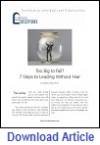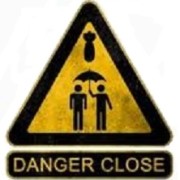Too Big to Fail? 7 Steps to Leading Without Fear
 The scene. 4:30 a.m. hotel shuttle bus to LAX airport. Not exactly the place I expect to bump into a life lesson. But sometimes the travel gods have other plans for me.
The scene. 4:30 a.m. hotel shuttle bus to LAX airport. Not exactly the place I expect to bump into a life lesson. But sometimes the travel gods have other plans for me.
The scene played out like this: youngish guy sitting on the hard bench seat opposite me, friendly smile playing across his face as he scans the mostly older crowd of seasoned business travelers. After a minute or two, he strikes up a conversation with a middle-aged (okay, my-aged) guy sitting next to him and soon they are in as intense a discussion as a 10 minute van ride can create. From the safety of my protective “I’m an introvert, don’t talk to me” bubble across the aisle, I admire the seeming ease with which he engages the man.
First stop at a terminal, the my-aged guy gets off, along with most of the other riders, then another stop and another decampment of bodies and roll-a-boards, until it’s just me, the driver and the friendly young guy. His eyes fall upon me. “Hi!” he says with a smile. “How you doing this morning?” I debate how to both answer and evade a longer conversation. “Fine,” I respond. “Whatcha here for?” he asks. “A meeting,” I answer, figuring a generic response like that will prove enough to satisfy him.
“What kind of meeting?” he queries, still smiling.
And then I relent, muster my energy, and begin to explain what I do. “I’m an executive coach. I was here to observe a client and his leadership team and then to provide feedback to my client on what I saw.” He lights up with interest, “Cool!” The van pulls up to our terminal, we grab our bags and head inside to gauge the security lines. As we wait in the “premiere flyer” security line (which is moving only slightly faster than the normal line), he peppers me with more questions, explaining that he is very curious about leadership and what good leadership looks like. I warm to the task and expound for a while.
Then I turn the tables and ask him what he does. He shares that he has just been promoted into a new national accounts sales team in his Fortune 500 company and is the youngest member of the team, by far. I venture what I think to be an empathic response: “That must be a lot of pressure!”
And here’s where the lesson shows up.
“Not at all!” he quickly answers with a big grin. “I figure I’ve got absolutely nothing to lose as the young guy. I can make lots of mistakes and learn from them and get better. I’m loving the freedom to fail that I feel.”
I’ll have what he’s having. I’m still walking around thinking about that young man two weeks later. Musing at his sense of absolute freedom from a fear of failure…what a contrast to the sense of fear, or at least concern, about failure that so many of my leader clients express (and that I resonate with as well).
Where do we lose that sense of freedom – or do some of us never have it in the first place? Is it a matter of life experience and/or personality traits? My own hypothesis is that it’s a mixture of both. But frankly, I’m less interested in where it’s gone than I am in how we can cultivate it – whether to recapture something we once had or to create it anew.
A method for cultivating freedom. I call this exercise “sitting in the sandbox” when I use it with clients. (Some of my cognitive-behaviorally trained brethren would call it a modified form of exposure therapy). Take your most feared failure, the one you’ve been trying to outrun through working harder, putting in longer hours, playing nice, or just pushing any thoughts of it away, and allow yourself to play with it just for a little while. Set aside everything else and do some focused “what if-ing”: what if you were to fail in that way? What if the negative or feared consequences occurred – what would that be like?
Allow all the images, feelings and scenarios to wash over you.
And, finally, the piece de resistance: what would you do if the worst consequences actually played out? (Not a pure “what if” lead-in there but you get the picture.) Spend several more minutes on that, actually visualizing what you would do in the face of those negative consequences. What actions might you take? Who else would you involve? And what parts of yourself would you call upon for strength and guidance? Keep the imagining up until you run out of steam. Then, breathe deeply, get up and step out of that mental sandbox and back into your real life.
For most of us, the experience of playing with our worst fears or biggest concerns for a few concentrated moments will bring surprisingly positive results.
The method in practice. I worked with a client a few years back who felt trapped in his mid-level leadership role, afraid to push on the parts of the organizational system around him that regularly sapped him of precious creativity and passion for his work. He would cite his need to keep his job, given two kids in college, etc. and skate right away from my questions about what held him back from exploring remedies for his frustration.
Finally, one session, I introduced the sandbox metaphor. He begrudgingly followed me into it. We played for a little while, exploring: “what if you pushed against your boss on these issues? What if he became very unhappy with you? What if you lost your job?” and with each “What if?” he imagined how he would feel and what he might do. By the end of the exercise, he was sitting straighter in his chair, a surprised smile on his face. “Wow, I guess it wouldn’t be as bad as I feared…I mean, I wouldn’t necessarily WANT those events to happen but if they did, I have things I could do. I think I’d actually be okay.” And I submit that he is absolutely right about that.
“Sitting in the sandbox” process.
- Find a whitespace in your schedule. Preferably at least 10 – 15 minutes. Have a journal or your laptop nearby if you would get value out of writing down your insights.
- Get in the sandbox. Set your intention. It’s important here that you commit to just sitting and playing with this mental exercise and the imagery that is involved. Nothing heavy. Sometimes it helps to literally state to yourself something like: “okay, I’m just going to get in the mental sandbox a bit with this one, to play a little and see what I might find.”
- Identify what you are afraid of by looking at what you’ve been trying to outrun, outthink or avoid in your day-to-day life. What “third rail” concerns or feared failures sit at the base of those defensive maneuvers? You’ll know you’ve hit one when you feel a significant negative emotional charge with it.
- Visualize that feared scenario actually occurring. If it helps you to do so, close your eyes and take several deep breaths. Let a few scenes play out: what events would likely unfold? who might be involved and what are they doing? how would you act, feel and think? Spend a few minutes just letting your imagination take over, noticing the images, thoughts and feelings that come with it.
- Develop your response. Continuing to visualize, guide your imagination now in the direction of how you might respond in the face of that feared scenario. What meaningful actions would you take to move toward a more desirable outcome and/or minimize the feared consequences? Which of your strengths would you call forward? How would you manage your feelings and recover? To whom could you look for support? Allow this part of the visualization to play out until you achieve a sense of greater lightness or relief of the emotional charge that accompanied step #4.
- Get out of the sandbox. Close down the exercise by reflecting over what you’ve learned. A great question to answer here is, “what do I know now that I didn’t know before I began the exercise?” Write out 2 -3 answers if that helps. Speak the insights out loud in the privacy of your office, giving them voice. Call a friend or trusted colleague to share the highlights. Then brush yourself off (metaphorically) and get back to your day.
- Repeat as needed. One trip to the sandbox may be enough for some concerns; more entrenched, long-standing fears may take several trips, spread over a period of time. The good news is the sandbox is always there, awaiting your arrival.
Final thoughts. Thanks to that young man on the hotel shuttle, I’ve been reminded of the greater sense of freedom that is within all of our grasp. Where could you benefit from more openness to taking risks, making mistakes, and even to failing? Name it and go sit in the sandbox.
I think you’ll be happy you did.









